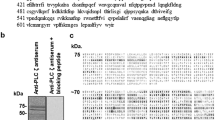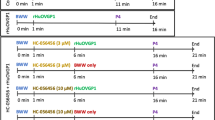Abstract
The purpose of this study was to determine the role of Ang-II in buffalo spermatozoa; localize angiotensin type 1 (AT1) receptors on the sperm surface and understand the signaling mechanisms involved therein. Immunoblotting and immunocytochemistry using polyclonal Rabbit anti-AT1 (N-10) IgG were performed to confirm the presence of AT1 receptors. Intracellular levels of cyclic adenosine monophosphate (cAMP) were determined by non-radioactive enzyme immunoassay, while that of Calcium [Ca2+] were estimated by fluorimetry using Fura2AM dye. The results obtained showed that AT1 receptors were found on the post-acrosomal region, neck and tail regions. Immunoblotting revealed a single protein band with molecular weight of 40 kDa. Ang-II treated cells produced significantly higher level of cAMP compared to untreated cells (22.66 ± 2.4 vs. 10.8 ± 0.98 pmol/108 cells, p < 0.01). The mean levels of Ca2+ were also higher in Ang-II treated cells compared to control (117.4 ± 6.1 vs. 61.15 ± 4.2 nmol/108 cells; p < 0.01). The stimulatory effect of Ang-II in both the cases was significantly inhibited in the presence of Losartan (AT1 antagonist; p < 0.05) indicating the involvement of AT1 receptors. Further, presence of neomycin (protein kinase C inhibitor) inhibited significantly the Ang-II mediated rise in Ca2+ indicating the involvement of PKC pathway. These findings confirm the presence of AT1 receptors in buffalo spermatozoa and that Ang-II mediates its actions via the activation of these receptors. Ang-II stimulates the rise in intracellular levels of cAMP and Ca2+ during capacitation.






Similar content being viewed by others
References
O’Mahony OA, Djahanbahkch O, Mahmood T, Vinson GP (2000) Angiotensin-II in human seminal fluid. Hum Reprod 15:1345–1349
Vinson GP, Mehta J, Evans S, Mathews JR, Puddeffot SE, Holt WV, Djahanbakhch O (1996) Angiotensin II stimulates sperm motility. Regul Pept 67:131–135
Sabeur K, Vo AT, Ball BA (2000) Effects of angiotensin II on the acrosome reaction in equine spermatozoa. J Reprod Fertil 120:135–142
Mededovic S, Fraser LR (2004) Ang-II stimulates cAMP production and protein tyrosine phosphorylation in mouse spermatozoa. Reproduction 127:601–612
Husain A, Bumpus FM, DeSilva P et al (1987) Localization of angiotensin-II receptors in ovarian follicles and the identification of angiotensin-II in rat ovaries. Proc Natl Acad Sci USA 84:2489–2493
Heimler I, Rawlins RG, Binor Z, Aiman J, Raff H, Hutz RJ (1995) Elevated follicular fluid angiotensin II and pregnancy outcome. Fertil Steril 63:528–534
Ball BA, Gravance CG, Wessel MT, Sabeur K (2003) Activity of angiotensin-converting enzyme (ACE) in reproductive tissues of the stallion and effects of angiotensin II on sperm motility. Theriogenology 59:901–914
Mededovic S, Fraser LR (2005) Mechanisms of action of angiotensin II on mammalian sperm function. Reproduction 129:211–218
Gur Y, Breitbart H, Lax Y, Rubinstein S, Zamir N (1998) Angiotensin II induces acrosomal exocytosis in bovine spermatozoa. Am J Physiol 275:E87–E93
Vedantam S, Atreja SK, Garg M (2012) Angiotensin-II induced nitric oxide production during buffalo sperm capacitation and acrosome reaction. Res Vet Sci 92:207–212
Griendling KK, Lassegue B, Alexander RW (1996) Angiotensin receptors and their therapeutic implications. Ann Rev Pharmacol Toxicol 36:281–306
Timmermans PB, Wong PC, Chiu AT et al (1993) Angiotensin II receptors and Angiotensin II receptor antagonists. Pharmacol Rev 45:205–251
De Gasparo M, Catt KJ, Inagami T, Wright JW, Unger TH (2000) International union of pharmacology. XXIII. The angiotensin II receptors. Pharmacol Rev 52:415–472
Vinson GP, Ho MM, Puddefoot JR (1995) The distribution of Ang-II type 1 receptors and the tissue renin-angiotensin systems. Mol Med Today 1:35–39
Wennemuth G, Babcock DF, Hille B (1999) Distribution and function of angiotensin II receptors in mouse spermatozoa. Andrologia 31:323–325
Fraser LR, Pondel MC, Vinson GP (2001) Calcitonin, angiotensin II and FPP significantly modulate mouse sperm function. Mol Hum Reprod 7:245–253
Parrish JJ, Susko-Parish J, Winer MA, First NL (1988) Capacitation of bovine sperm by heparin. Biol Reprod 38:1171–1180
Galantino-Homer HL, Visconti PE, Kopf GS (1997) Regulation of protein tyrosine phosphorylation during bovine sperm capacitation by a cyclic adenosine 3′,5′-monophosphate-dependent pathway. Biol Reprod 56:707–719
Laemmli UK (1970) Cleavage of structural proteins during the assembly of the head of bacteriophage T4. Nature 227:680–685
Otter T, King SM, Witman GB (1987) A two-step procedure for efficient electrotransfer of both high-molecular (>400,000) and low-molecular-weight (<20,000) proteins. Anal Biochem 162:370–377
Grynkiewicz G, Poenie M, Tsien YR (1985) A new generation of Ca2+ indicators with greatly improved fluorescence properties. J Biol Chem 260:3440–3450
Dragileva E, Rubinstein S, Breitbart H (1999) Intracellular Ca2+ -Mg2+-ATPase Regulates calcium Influx and acrosomal exocytosis in bull and ram spermatozoa. Biol Reprod 61:1226–1234
Vinson GP, Puddefoot JR, Ho MM (1995) Type 1 angiotensin II (AT1) receptors in rat and human sperm. J Endocrinol 144:369–378
Foresta C, Rossato M (1997) Calcium influx pathways in human spermatozoa. Mol Hum Reprod 3:1–4
Fraser LR (1993) Calcium channels play a pivotal role in the sequence of ionic changes involved in initiation of mouse sperm acrosomal exocytosis. Mol Reprod Dev 36:368–376
Yanagimachi R (1994) Mammalian fertilization. In: Knobil E, Neill JD (eds) The physiology of reproduction. Raven Press, New York, pp 189–317
Thomas P, Meizel S (1988) An influx of extracellular calcium is required for initiation of the human sperm acrosome reaction induced by follicular fluid. Gamete Res 20:397–411
Florman HM (1994) Sequential focal and global elevations of sperm intracellular Ca2+ are initiated by the zona pellucida during acrosomal exocytosis. Dev Biol 165:152–164
Suraj K, Atreja SK (2000) Heparin induced capacitation of buffalo spermatozoa. 69th Annual Meeting of the Society of Biological Chemists (India) at Science City, Calcutta, Dec 8-11, Abstract No. J8-P201
Baldi E, Casano R, Falsetti C, Krausz CS, Maggi M, Forti G (1991) Intracellular calcium accumulation and responsiveness to progesterone in capacitating human spermatozoa. J Androl 12:323–330
Griendling KK, Tsuda T, Berk BC, Alexander RW (1989) Angiotensin II stimulation of vascular smooth muscle cells. Am J Physiol 2:659–665
Thomas MK, Francis SH, Corbin JD (1990) Characterization of a purified bovine lung cGMP-binding cGMP phosphodiesterase. J Biol Chem 265:14971–14978
Ballard SA, Gingell CJ, Tang K, Turner LA, Price ME, Naylor AM (1998) Effects of sildenafil on the relaxation of human corpus cavernosum tissue invitro and on the activities of cyclic nucleotide phosphodiesterase isozymes. J Urol 159:2164–2171
Stadel J, Crook S (1988) Differential effects of fluoride on adenylate cyclase activity receptor binding. Biochem J 254:15–20
Cooper DMF, Nicole M, Karpen JW (1995) Adenylyl cyclases and the interaction between calcium and cAMP signalling. Nature 374:42–424
Tang WJ, Hurley JH (1998) Catalytic mechanism and regulation of mammalian adenylyl cyclases. Mol Pharmacol 54:231–240
Antoni FA (2000) Molecular diversity of cyclic AMP signalling. Front Neuroendocrinol 21:103–132
Buck JS, Schapal ML, Cann MJ, Levin LR (1999) Cytosolic adenylyl cyclase defines a unique signaling molecule in mammals. Proc Nat Acad Sci 96:79–84
Jaiswal BS, Conti M (2003) Calcium regulation of the soluble adenylyl cyclase expressed in mammalian spermatozoa. Proc Nat Acad Sci 100:10676–10681
Acknowledgments
The authors are grateful to the Indian Council of Agricultural Research (ICAR) for funding this project.
Author information
Authors and Affiliations
Corresponding author
Rights and permissions
About this article
Cite this article
Vedantam, S., Rani, R., Garg, M. et al. Localization of angiotensin-II type 1(AT1) receptors on buffalo spermatozoa: AT1 receptor activation during capacitation triggers rise in cyclic AMP and calcium. Mol Biol Rep 41, 1959–1965 (2014). https://doi.org/10.1007/s11033-014-3043-7
Received:
Accepted:
Published:
Issue Date:
DOI: https://doi.org/10.1007/s11033-014-3043-7




